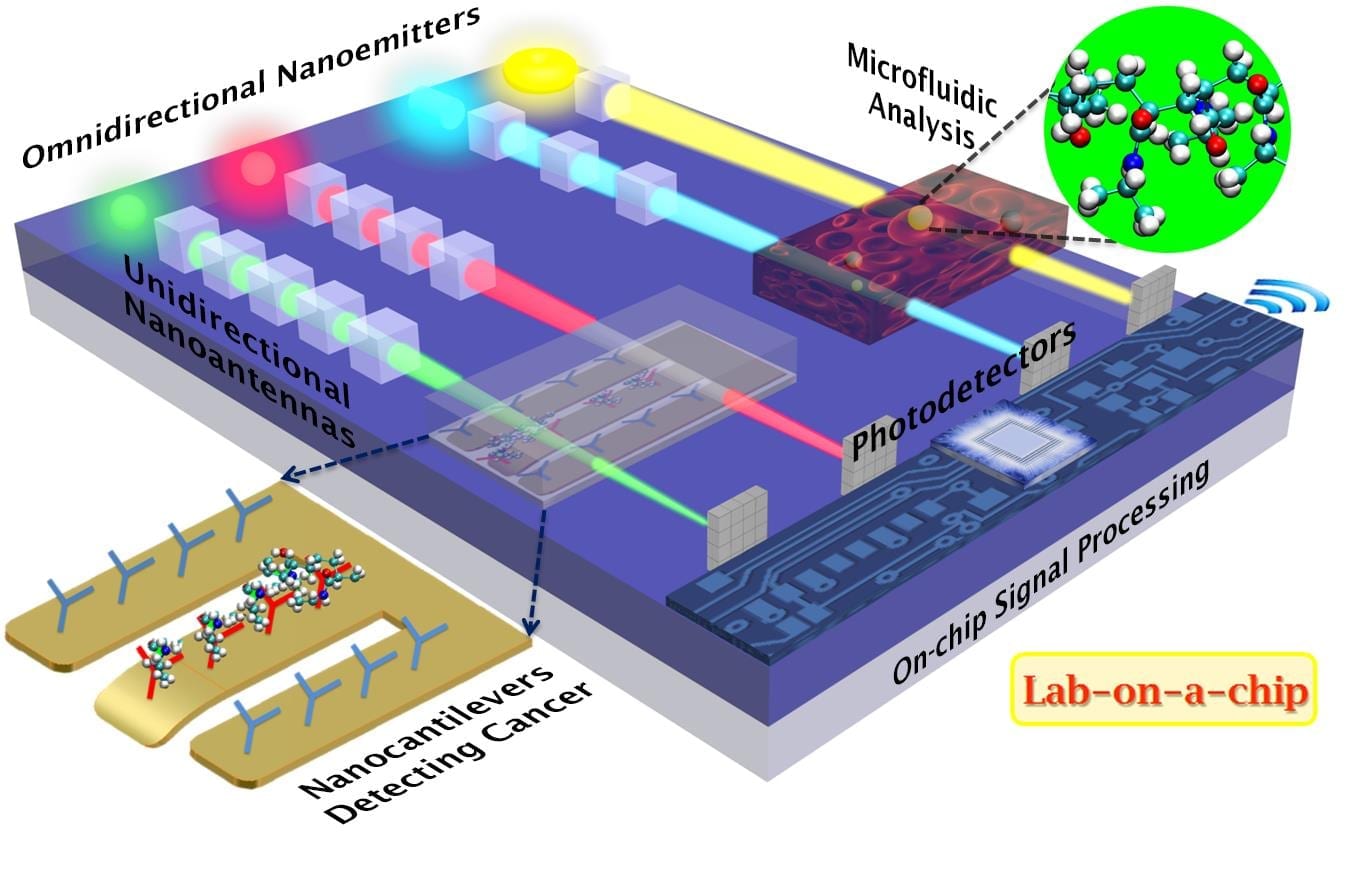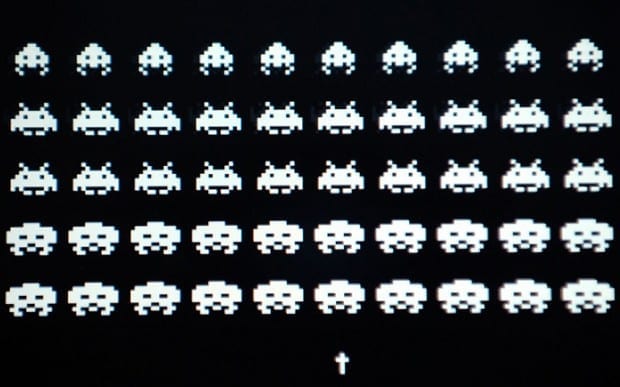
Schematic representation of unidirectional cubic nanoantennas inducing directionality to omnidirectional nanoemitters (light sources, e.g., spasers, quantum dots), to precisely focus light with adjustable beam width and intensity, which can be tuned by adjusting the length of nanocube chain or intercube spacing. These ultra-narrow directional beams can play multiple roles in lab-on-a-chip devices such as illumination sources in microfluidic analysis or minute deflection registers in nanocantilever based sensors. All these signals are further detected in the photodetectors and get processed by on-chip signal processing circuitry for bio-molecular identification.
New research shows how cubic nanostructures made of insulating materials overcome the heating, fabrication and intensity challenges of nanonantenna technology, paving the way for NEMS applications in biomedicine, nanolasers and photovoltaics.
Newly developed tiny antennas, likened to spotlights on the nanoscale, offer the potential to measure food safety, identify pollutants in the air and even quickly diagnose and treat cancer, according to the Australian scientists who created them. The new antennas are cubic in shape. They do a better job than previous spherical ones at directing an ultra-narrow beam of light where it is needed, with little or no loss due to heating and scattering, they say.
In a paper published in the Journal of Applied Physics, from AIP Publishing, Debabrata Sikdar of Monash University in Victoria, Australia, and colleagues describe these and other envisioned applications for their nanocubes in “laboratories-on-a-chip.” The cubes, composed of insulating, rather than conducting or semiconducting materials as were the spherical versions, are easier to fabricate as well as more effective, he says.
Sikdar’s paper presents analysis and simulation of 200-nanometer dielectric (nonconductive) nanoncubes placed in the path of visible and near-infrared light sources. The nanocubes are arranged in a chain, and the space between them can be adjusted to fine-tune the light beam as needed for various applications. As the separation between cubes increases, the angular width of the beam narrows and directionality improves, the researchers say.
“Unidirectional nanoantennas induce directionality to any omnidirectional light emitters like microlasers, nanolasers or spasers, and even quantum dots,” Sikdar said in an interview. Spasers are similar to lasers, but employ minute oscillations of electrons rather than light. Quantum dots are tiny crystals that produce specific colors, based on their size, and are widely used in color televisions. “Analogous to nanoscale spotlights, the cubic antennas focus light with precise control over direction and beam width,” he said.
The new cubic nanoantennas have the potential to revolutionize the infant field of nano-electromechanical systems (NEMS). “These unidirectional nanoantennas are most suitable for integrated optics-based biosensors to detect proteins, DNA, antibodies, enzymes, etc., in truly portable lab-on-a-chip platforms of the future,” Sikdar said. “They can also potentially replace the lossy on-chip IC (integrated circuit) interconnects, via transmitting optical signals within and among ICs, to ensure ultrafast data processing while minimizing device heating,” he added.
Read more: Optical Nanoantennas Set the Stage for a NEMS Lab-on-a-Chip Revolution
The Latest on: NEMS Lab-on-a-Chip
[google_news title=”” keyword=”NEMS Lab-on-a-Chip” num_posts=”10″ blurb_length=”0″ show_thumb=”left”]
via Google News
The Latest on: NEMS Lab-on-a-Chip
- Grounded: How To Get The Haze Lab BURGL Chipon May 1, 2024 at 4:05 am
Obtaining the BURG.L chip from the Haze Lab in Grounded requires players to complete a few steps before claiming the prize. Your browser does not support the video ...
- Networks on Chip - Challenges and Solutionson April 28, 2024 at 5:00 pm
Email: {parthap, grecuc, ivanov, res} @ece.ubc.ca The University of British Columbia’s System-on-a-Chip (SoC) Research lab has established itself as a world-class research centre for the design, ...
- China Creates 'Neucyber,' Its Version of a Neuralink Brain Chipon April 25, 2024 at 5:58 am
China has reportedly developed a brain-computer interface chip called Neucyber that allows a monkey to control a robotic arm with only its thoughts.
- MIT Technology Reviewon April 16, 2024 at 5:01 pm
Chip companies from the US and China are developing ... it hopes could challenge Ajinomoto’s monopoly. It already has a lab product with impressive attributes but still needs to test it in ...
- An Introduction to Lab-on-a-Chip Technology in Clinical Diagnostics: Successes and Remaining Challengeson March 26, 2024 at 12:00 am
Lab-on-a-chip platforms enable advanced processing, manipulation, and analysis of biological samples in miniaturized fluidic devices. Despite the numerous advantages, such as lower reagent and sample ...
- Lab on a Chip News and Researchon November 1, 2023 at 5:00 pm
Researchers described the development and applications of a 3D-printed lab-on-a-chip device that quickly detected the presence of SARS-CoV-2 in patient's saliva. A University of Texas at Arlington ...
- Lab on a Chipon November 9, 2022 at 4:40 am
These must represent a significant development in the particular field, and are judged according to originality, quality of scientific content and contribution to existing knowledge. Although there is ...
- 2021 Lab on a Chip outstanding peer reviewerson April 19, 2022 at 6:47 am
Every one of our peer reviewers makes a significant contribution to great science. To celebrate those going above and beyond, each year our Lab on a Chip editorial team evaluates peer reviewers based ...
- MEMS Explained – A Comprehensive Guide to Microelectromechanical Systemson September 12, 2021 at 7:18 am
For example, a MEMS for laboratory testing (lab-on-a-chip) can be designed with sensors to measure the ... The logical continuation of further miniaturization will lead from MEMS to NEMS – ...
- Lab on a Chip Technologies for Drug Discoveryon May 30, 2019 at 9:00 am
In this seminar, Dr Elvira will talk about the use of droplet microfluidic technologies for drug discovery. Initially, she will discuss the fundamental concepts of droplet microfluidic technologies, ...
via Bing News










